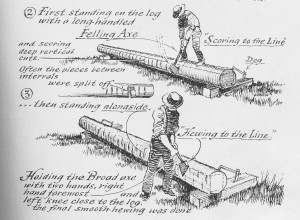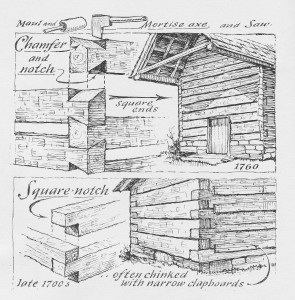Today, with the help of artist/writer Eric Sloane, I’d like to share with you the process of starting with a tree and then making a home out of it… with just a few basic tools… no manufacturing facility necessary!
There are two things about this drawing that I’d like to comment on…
One is that we have improved upon this antique version of a chalk line. This device marks the length of the log with a line that will be our guide in hewing the log (creating a flat surface on the inside and out). This diagram envisions this log to be hewn with an axe on all four sides which would create a floor joist (or ceiling beam).
My experience in working with old logs, and in performing this same technique today on fresh cut logs, is that rarely is the complete log de-barked. That’s a lot of work that will only be discarded by next phase of the work anyway. (I and most log workers of the past would just remove the bark where the line would be snapped)
The next step would be the axe work. First you stand on the log and cut away the wood at regular intervals down the length of the log, cutting back to your marked line with each finishing cut.
Then you go back down the length of the log with this same axe knocking out the chunks of wood left in between your knotches.
Next, you come back with a special axe… a broad axe… an axe with a large head and is beveled only on one side, which smooths the log down to the finish we see on old log cabins.
The process, for me at least, is labor intensive, but I have witnesses men who can swing an axe with more ease than a carpenter swings a hammer, men who could do this type of work all day long. It’s amazing to watch.
These hewn logs would then be used to create a log home or outbuilding.
Eric Sloane does an incredible job of displaying the beauty of a half dovetail notch doesn’t he? But the notches he drew on the second log corner, (which I would call a half-lap joint), must be a New England method of notching. Here in Virginia we have a square notch also, which is always used on outbuildings and barns, where the ends of the logs are squared and large pegs are driven down through each log end, once it is laid.
Another exception that I would take note of is that it appears the logs in this drawing have been all been hewn on all four sides, which I have never seen on any cabin. Maybe again, it’s a New England feature? I find that log cabins are much more attractive with the natural curves and unique shape of the original log. (this is a major failing in so many log cabin kits)
This sketch is from Eric Sloane’s book “Museum of Early American Tools” which is one the books on my recommended reading list that I offered a few weeks ago. I’d like to share a few more of Sloane’s sketches with you in the coming day or two… I think you’ll enjoy them.
BTW… I have four duplicate copies of four different books of Sloane’s (one that is out of print) that I’m giving away to four different people that sign up by Monday. I’m going to do a random drawing of those on the list… I’ll shoot the winners an email and ask for an address. … if you get my free list of the books I recommend reading you will be automatically signed up. Oh… one last thing… those that signed up to get the free guide prior to this last weekend, there was a technical issue… you did receive your guide, but you weren’t signed up… sorry about that… please, try again, thanks… I’m afraid that I am a much better builder than I am a techie. Noah
Originally posted 2015-08-07 14:35:19.



